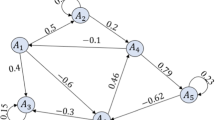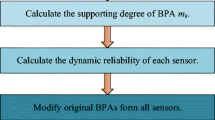Abstract
In time-series environments, uncertain knowledge among variables in a time slice can be represented and modeled by a Bayesian network (BN). In this paper, we are to achieve the global uncertain knowledge during a period of time for decision-making or action selection by fussing or combining the participating uncertainties of multiple time slices consistently while satisfying the demands of high efficiency and instantaneousness. We adopt qualitative probabilistic network (QPN), the qualitative abstraction of BN, as the underlying framework of modeling and fusing time-series uncertain knowledge. The BNs in continuous time slices constitute time-series BNs, from which we derive time-series QPNs. Taking time-series BNs as input, we propose a QPN-based approach to fuse time-series uncertainties in line with temporal specialties. First, for each time slice, we enhance the implied QPN by augmenting interval-valued weights derived from the corresponding BN, and then obtain the QPN with weighted influences, denoted EQPN (Enhanced Qualitative Probabilistic Network), which provides a quantitative and conflict-free basis for fusing uncertain knowledge. Then, we give the method for fusing the graphical structures of time-series EQPNs based on the concept of Markov equivalence. Following, we give a superposition method for fusing qualitative influences of time-series EQPNs. Experimental results show that our method is not only efficient, but also effective. Meanwhile, the simulation results when applying time-series EQPNs and the fusion algorithm to a robotic system show that our method is applicable in realistic intelligent situations.





















Similar content being viewed by others
References
Andersson S, Madigan D, Perlman M (1997) A characterization of Markov equivalence classes for acyclic digraphs. Ann Stat 25:505–541
Bolt J, Van der Gaag L, Renooij S (2005) Introducing situational signs in qualitative probabilistic networks. Int J Approx Reason 38(3):333–354
Buntine W (1996) A guide to the literature on learning probabilistic networks from data. IEEE Trans Knowl Data Eng 8(2):195–210
Cheng J (1998) PowerConstructor system. http://www.cs.ualberta.ca/~jcheng/bnpc.htm
Cheng J, Bell D, Liu W (1997) Learning Bayesian networks from data: an efficient approach based on information theory. In: Proceeding of conference CIKM, pp 325–331
Chickering D (1995) A transformational haracterization of Bayesian network structures. In: Proceeding of conference UAI, pp 87–98
Chickering D (2002) Learning equivalence classes of Bayesian-network structures. J Mach Learn Res 2:445–498
Cooper G (1990) The computational complexity of probabilistic inference using Bayesian belief networks. Artif Intell 42(2–3):393–405
de Campos C, Cozman F (2005) Belief updating and learning in semi-qualitative probabilistic networks. In: Proceeding of conference UAI, pp 153–160
de Campos C, Cozman F (2013) Complexity of Inferences in polytree-shaped semi-qualitative probabilistic networks. In: Proceeding of conference AAAI, pp 217–223
Dor D, Tarsi M (1992) A simple algorithm to construct a consistent extension of a partially oriented graph. Technical Report R-185, Cognitive Systems Laboratory, UCLA Computer Science Department
Druzdzel M (1993) Probabilistic reasoning in decision support systems: from computation to common sense. Ph.D. thesis, Department of Engineering and Public Policy, Carnegie Mellon University, Pennsylvania
Druzdzel M, Henrion M (1993) Efficient reasoning in qualitative probabilistic networks. In: Proceeding of national conference artificial intelligence, pp 548–553
Geiger D, Heckerman D (1996) Knowledge representation and inference in similarity networks and Bayesian multinets. Artif Intell 82:45–74
Guo H, Hsu W (2002) A survey of algorithms for real-time Bayesian network inference. In: Proceeding of the joint AAAI-02/KDD-02/UAI-02 workshop on real-time decision support and diagnosis systems
Hwang K, Park H, Cho S (2009) Robotic intelligence with behavior selection network for Bayesian network ensemble. In: Proceeding of RIISS workshop, pp 151–154
Ibrahim Z, Ngom A, Tawfik A (2011) Using qualitative probability in reverse-engineering gene regulatory networks. IEEE/ACM Trans Comput Biol Bioinform 8(12):326–334
Lazkano E, Sierra B, Astigarraga A, Martinez-Otzeta J (2007) On the use of Bayesian networks to develop behaviours for mobile robots. Robot Auton Syst 55(3):253–265
Liu W, Guo L, Song N (2001) Fuzzy association degree with delayed time in temporal data model. J Comput Sci Technol 16(1):86–91
Liu W, Yue K, Liu S, Sun Y (2008) Qualitative-probabilistic-network-based modeling of temporal causalities and its application to feedback loop identification. Inform Sci 178(7):1803–1824
Matzkvich I, Abramson B (1992) The topological fusion of Bayes nets. In: Proceeding of conference UAI, pp 191–198
Maynard-Reid II P, Chajewska U (2001) Aggregating learned probabilistic beliefs. In: Proceeding of conference UAI, pp 354–361
Meek C (1995) Causal inference and causal explanation with background knowledge. In: Proceeding of conference UAI, pp 403–410
Nielsen S, Parsons S (2007) An application of formal argumentation: Fusing Bayesian networks in multi-agent systems. Artif Intell 171:754–775
Norsys Software Corp (2007) Netica 3.17 Bayesian network software from Norsys. http://www.norsys.com
Pearl J (1988) Probabilistic reasoning in intelligent systems: networks of plausible inference. Morgan Kaufmann, San, Mateo
Pennock D, Wellman M (1999) Graphical representations of consensus belief. In: Proceeding of conference UAI, pp 531–540
Purwanto C, Rajasvaran L (2012) An enhanced hybrid method for time series prediction using linear and neural network models. Appl Intell 37(4):511–519
Renooij S, Van der Gaag LC (2008) Enhanced qualitative probabilistic networks for Resolving trade-offs. Artif Intell 172(12–13):1470–1494
Renooij S, Parsons S, Pardieck P (2003) Using kappas as indicators of strength in qualitative probabilistic networks. In: Proceeding of conference symbolic and qualitative approaches to reasoning with uncertainty, LNCS 2711, pp 87–99
Renooij S, Van der Gaag LC (2002) From qualitative to quantitative probabilistic networks. In: Proceeding of conference UAI, pp 422–429
Richardson M, Domingos P (2003) Learning with knowledge from multiple experts. In: Proceeding of conference ICML, pp 624–631
Russell S, Norvig P (2002) Artificial intelligence—a modern approach. Pearson Education, Publishing as Prentice-Hall, Boston
Sagrado J, Moral S (2003) Qualitative combination of Bayesian networks. Int J Intell Syst 18:237–249
Shafer G (1986) The combination of evidence. Int J Intell Syst 1:155–179
Tahboub K (2006) Intelligent human-machine interaction based on dynamic Bayesian networks probabilistic intention recognition. J Intell Robot Syst 45:31–52
Verma T, Pearl J (1990) Equivalence and synthesis of causal models. In: Proceeding of conference UAI, pp 220–227
Wellman M (1990a) Fundamental concepts of qualitative probabilistic networks. Artif Intell 44:257–303
Wellman M (1990b) Graphical inference in qualitative probabilistic networks. Networks 20:687–701
Yue K, Liu W (2009) Qualitative representation, inference and their application of uncertain knowledge: a survey on qualitative probabilistic networks. J Yunnan Univ (Nat Sci Ed) 31(6):560–570
Yue K, Yao Y, Li J, Liu W (2010) Qualitative probabilistic network with reduced ambiguities. Appl Intell 33(2):159–178
Yue K, Liu W, Yue M (2011) Quantifying influences in the qualitative probabilistic network with interval probability parameters. Appl Soft Comput 11(1):1135–1143
Acknowledgments
This work was supported by the National Natural Science Foundation of China (Nos. 61163003, 61232002, 71161015), the National Basic Research (973) Program of China (No. 2010CB328106), the Yunnan Provincial Foundation for Leaders of Disciplines in Science and Technology (No. 2012HB004), the Natural Science Foundation of Yunnan Province (No. 2013FB010), and the Research Foundation of Key Laboratory of Software Engineering of Yunnan Province (No. 2012SE013).
Author information
Authors and Affiliations
Corresponding author
Additional information
Communicated by V. Loia.
Rights and permissions
About this article
Cite this article
Yue, K., Qian, W., Fu, X. et al. Qualitative probabilistic network-based fusion of time-series uncertain knowledge. Soft Comput 19, 1953–1972 (2015). https://doi.org/10.1007/s00500-014-1381-y
Published:
Issue Date:
DOI: https://doi.org/10.1007/s00500-014-1381-y




